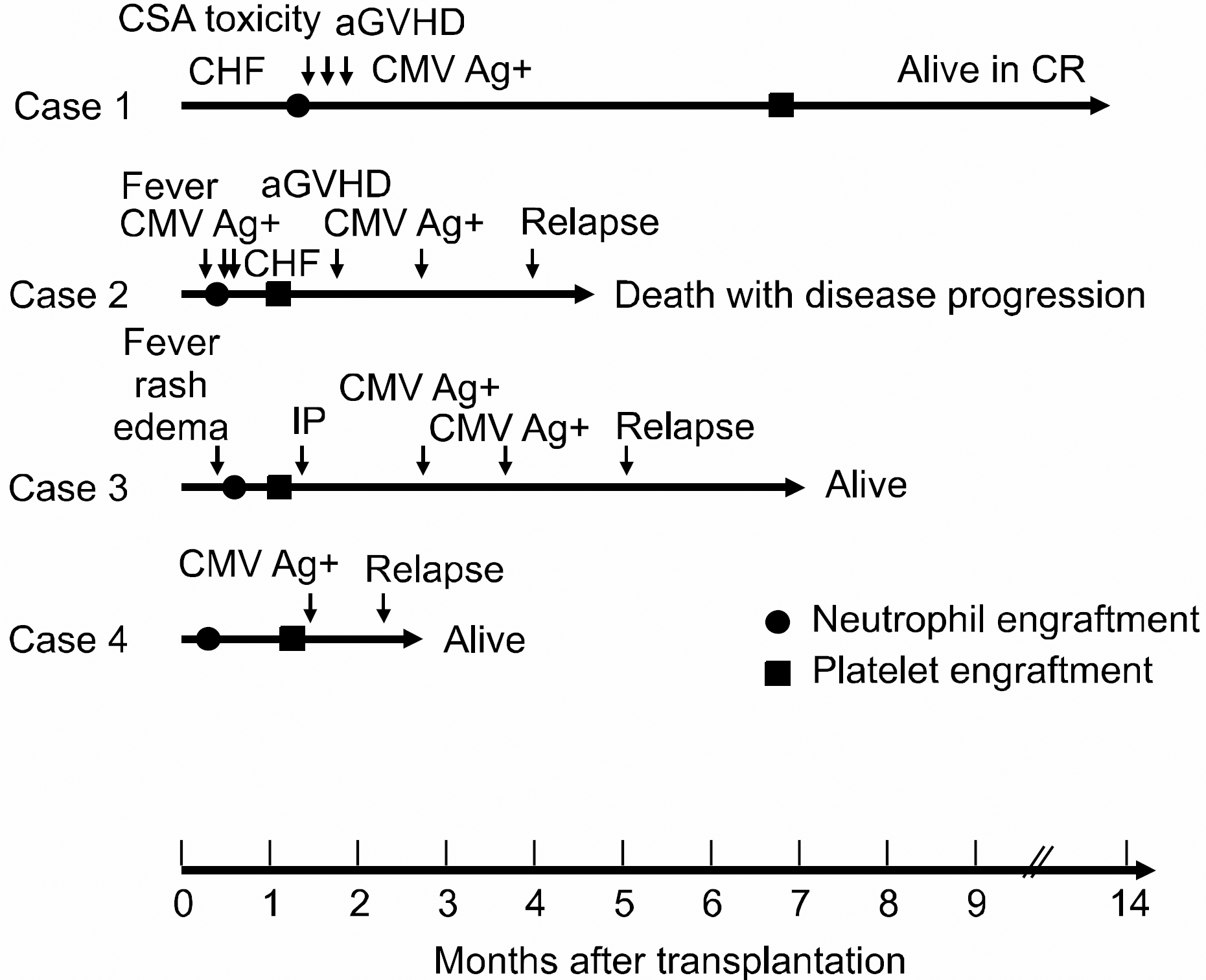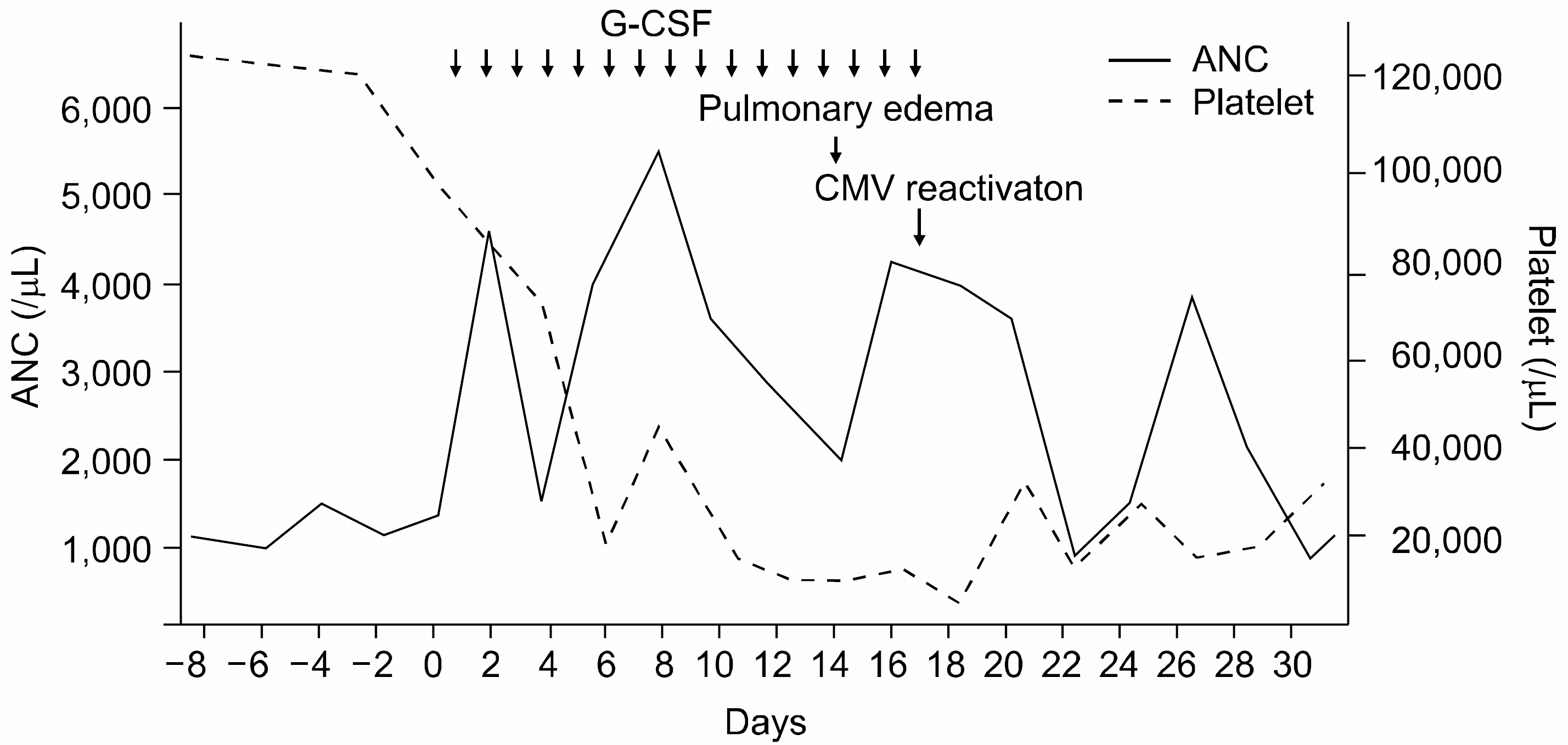Abstract
The outcome after unrelated cord blood transplantation (CBT) is similar to that of matched unrelated bone marrow transplantation in children, and the results of CBT in adult patients has recently shown improvement. In addition, the use of reduced-intensity conditioning regimens for CBT has shown stable engraftment and reduced treatment-related mortality (TRM). From May 2005 to Jan 2006, four adult patients with acute myelogenous leukemia were treated with CBT after reduced-intensity conditioning at our hospital. The mean age of patients was 53.8 yrs, and all patients received 2 HLA antigen mismatched single unit cord blood. The infused mean cell dose was 2.85×107/kg for total nucleated cells and 0.72×105/kg for CD34+ cells. All patients had engraftment. The mean number of days to WBC and platelet engraftment was D+20.3 and D+60.3, respectively. There was no TRM within 100 days after transplantation. At the last follow up, three of the four patients were alive. One patient transplanted in first complete remisson is alive in remission at day 413, but the other patients transplanted in advanced disease all relapsed. Reduced-intensity CBT is a feasible approach in selected adult patients with acute myeloid leukemia.
Go to : 
REFERENCES
1). Davies SM., Wagner JE., Weisdorf DJ, et al. Unrelated donor bone marrow transplantation for hematological malignancies-current status. Leuk Lymphoma. 1996. 23:221–6.

2). Gluckman E., Broxmeyer HA., Auerbach AD, et al. Hematopoietic reconstitution in a patient with Fanconi's anemia by means of umbilical-cord blood from an HLA-identical sibling. N Engl J Med. 1989. 321:1174–8.

3). Koo HH., Yoo KH., Sung KW, et al. Clinical results of cord blood stem cell transplantation in Korea. The Proceedings of The 3rd Annual meeting of Asian Hematology Association. 2005. 46.

4). Bradley MB., Cairo MS. Cord blood immunology and stem cell transplantation. Hum Immunol. 2005. 66:431–46.

5). Gluckman E., Rocha V. Cord blood transplant: strategy of alternative donor search. Semin Immun. 2004. 26:143–54.

6). Lane TA. Umbilical cord blood grafts for hematopoietic transplantation in adults: a cup half empty or half full? Transfusion. 2005. 45:1027–34.

7). Laughlin MJ., Barker J., Bambach B, et al. Hematopoietic engraftment and survival in adult recipients of umbilical-cord blood from unrelated donors. N Engl J Med. 2001. 344:1815–22.

8). Ooi J., Iseki T., Takahashi S, et al. Unrelated cord blood transplantation for adult patients with de novo acute myeloid leukemia. Blood. 2004. 103:489–91.

9). Takahashi S., Iseki T., Ooi J, et al. Single-institute comparative analysis of unrelated bone marrow transplantation for adult patients with hematologic malignancies. Blood. 2004. 104:3813–20.
10). Barker JN., Weisdorf DJ., DeFor TE., Blazar BR., Miller JS., Wagner JE. Rapid and complete donor chimerism in adult recipients of unrelated donor umbilical cord blood transplantation after reduced-intensity conditioning. Blood. 2003. 102:1915–9.

11). Rocha V., Labopin M., Sanz G, et al. Transplants of umbilical-cord blood or bone marrow from unrelated donors in adults with leukemia. N Engl J Med. 2004. 351:2276–85.
12). Laughlin MJ., Eapen M., Rubinstein P, et al. Out comes after transplantation of cord blood or bone marrow from unrelated donors in adults with leukemia. N Engl J Med. 2004. 351:2265–75.
13). Miyakoshi S., Yuji K., Kami M, et al. Successful engraftment after reduced-intensity umbilical cord blood transplantation for adult patients with advanced hematologic diseases. Clin Cancer Res. 2004. 10:3586–92.
14). Lee YH., Lee SW., Noh KT., Lee YS., Lee YA. Early inflammatory syndrome following cord blood stem cell transplantation. Korean J Hematol. 2004. 39:66–70.
Go to : 
 | Fig. 1Clinical courses of 4 patients with AML who received cord blood stem cell transplantation. Abbreviations: CSA, cyclosporine; CHF, congestive heart failure; CMV Ag+, CMV antigenemia; CR, complete remission; IP, interstitial pneumonitis. |
 | Fig. 2Changing profiles of absolute neutrophil count (ANC) and platelet count in patient (case 2) with AML who received cord blood stem cell transplantation. |
Table 1.
Characteristics of patients with acute myelogenous leukemia
| Case | Age/Sex | Body weight (kg) | Cytogenetic abnormality | Disease status at transplantation |
|---|---|---|---|---|
| 1 | 56/F | 60 | - | 1st CR |
| 2 | 49/F | 56 | t (15:17) | 3rd CR |
| 3 | 44/F | 51 | 7p (del) | 1st relapse |
| 4 | 66/M | 61 | Complex | 2nd relapse |
Table 2.
Characteristics of infused cord bloods and transplantation outcomes




 PDF
PDF ePub
ePub Citation
Citation Print
Print


 XML Download
XML Download